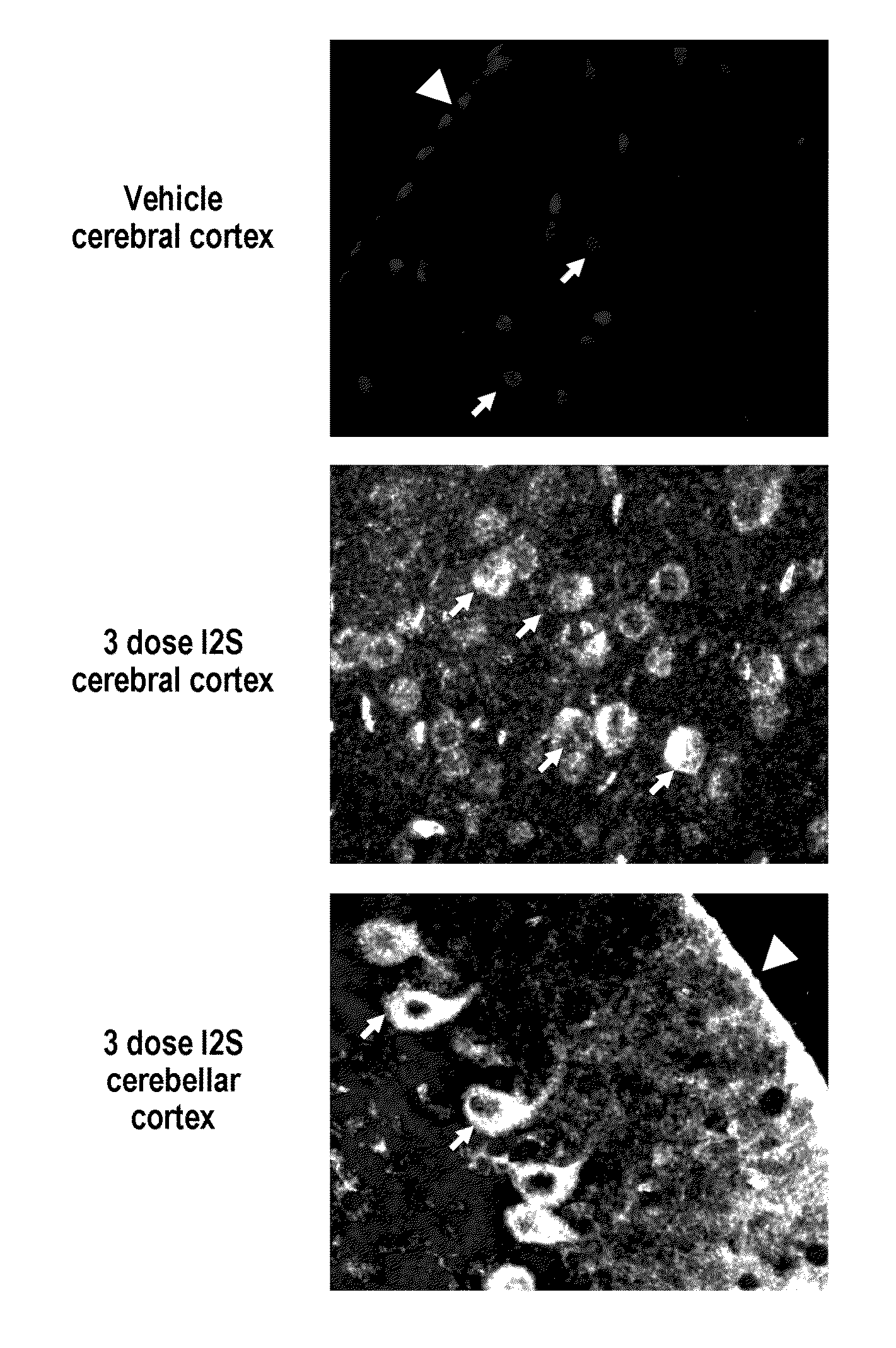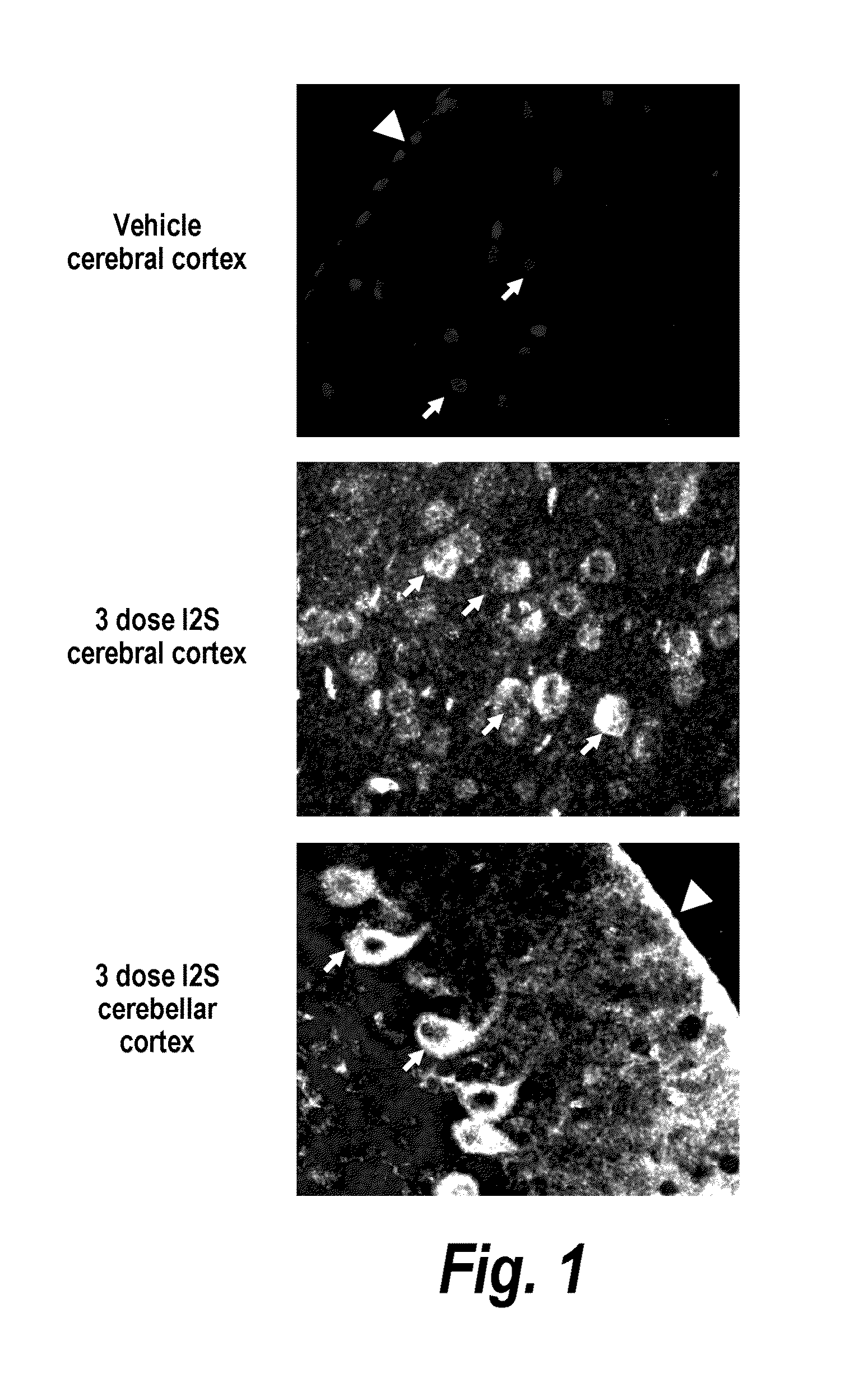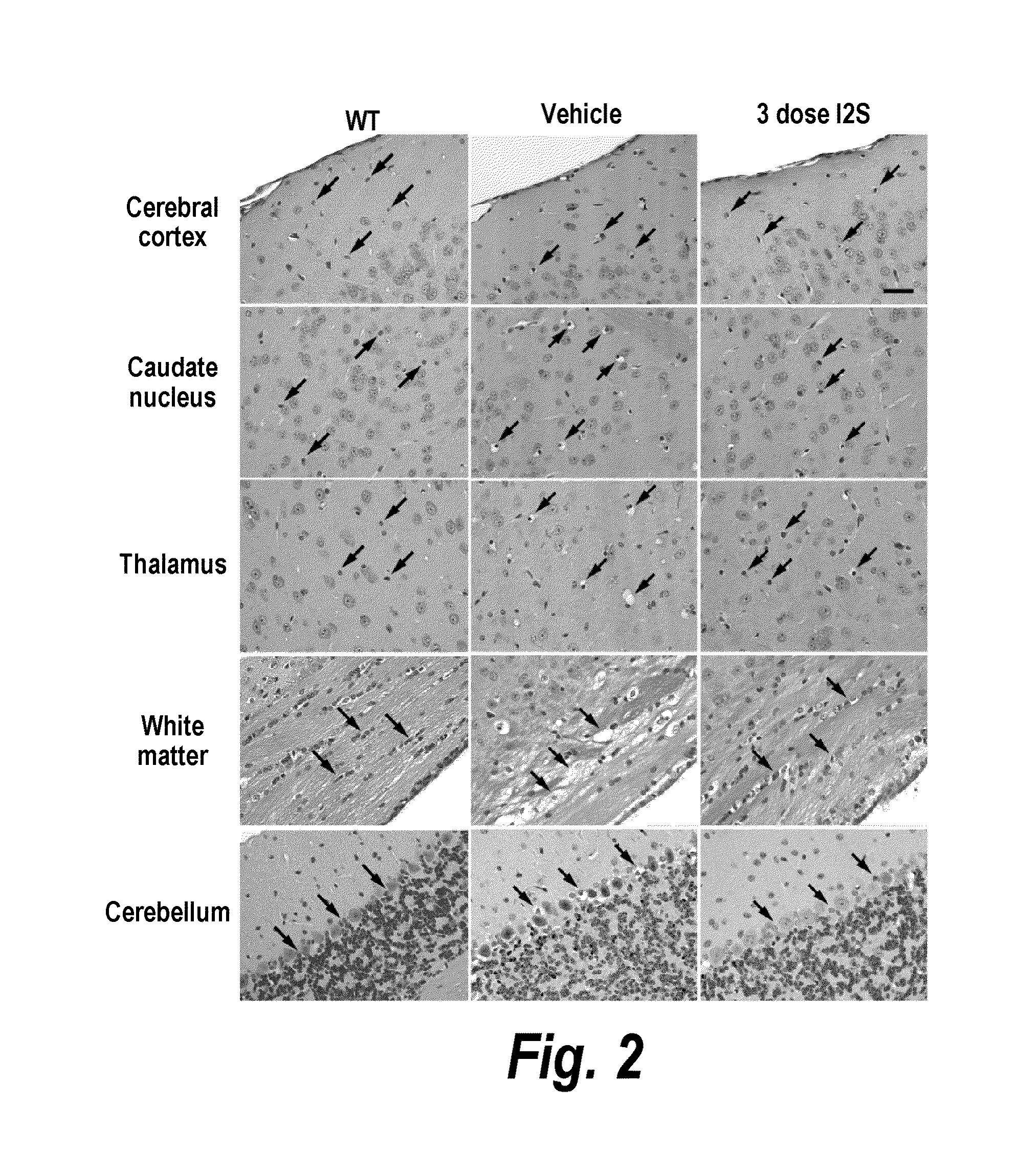Methods and compositions for CNS delivery of iduronate-2-sulfatase
a technology of iduronate and sulfatase, which is applied in the field of methods and compositions for cns delivery of iduronate2sulfatase, can solve the problems of poor diffusion of active agents from the site, tissue damage, immune response, etc., and achieves effective and less invasive approaches, high protein concentration delivery, and effective and extensive
- Summary
- Abstract
- Description
- Claims
- Application Information
AI Technical Summary
Benefits of technology
Problems solved by technology
Method used
Image
Examples
example 1
Biodistribution
[0279]The major objective of this study was to determine whether recombinant human I2S could be delivered to the brain of adult MPS II mice by the intrathecal-lumbar route
[0280]
TABLE 6Six groups of 8-12 week old male mice were treated as follows:Dose / Vol-BrainGroupNStrainTreatmentumeDoseweightRouteA3IKOI2S10 μL260 μg520 mg / kgIT-lumbarB3IKOI2S10 μL260 μg520 mg / kgIT-lumbarC3IKOUntreatedN / AN / AN / AN / AD1IKOI2S10 μL260 μg520 mg / kgIT-lumbarE3IKOUntreatedN / AN / AN / AN / AF3C57B1 / UntreatedN / AN / AN / AN / A6Injection schedule: Animals received up to 3 injections of idursulfase (10 L) via the intrathecal-lumbar route:Groups A & D: Administered 3 doses of I2S on days 1, 8, and 15Group B: Administered 2 doses of I2S on days 1 and 8Groups C & E: Untreated control (IKO) miceGroup F: Untreated wild-type control mice
Materials and Methods
Animals:
[0281]Mice were housed in groups of up to 4 per cage in a colony room under a 12-hour light-dark cycle. Rodent diet (LabDiet-5001, St Louis, Mo.) and wat...
example 2
Toxicology
[0302]This example illustrates the clinical signs associated with idursulfase via monthly bolus intrathecal lumbar doses in cynomolgus monkeys. To achieve this, 14 male, cynomolgus monkeys were randomly assigned to five treatment groups as shown in the following table.
[0303]
TABLE 7EXPERIMENTAL DESIGNGroupNumber of AnimalsNominal Dose (mg)Dose Volume (ml)1301233133301431501521001
[0304]Animals in all groups were dosed three times at monthly intervals IT at the level of the lumbar spine. The 1 ml dose volume was flushed from the catheter system with 0.3 ml of PBS. One to two days prior to each dosing, approximately 2 ml of CSF was collected from an IT spinal tap at the level of the cisterna magna. Blood samples (2 ml) were also collected at this time. Blood (2 ml) and CSF (0.1 ml) were collected from Group 5 animals predose, 0.5, 1, 2, 4, 8, 24, and 48 hours post dose after the first dose. Clinical signs were recorded at least twice daily. A necropsy was performed approximate...
example 3
PK (Serum and CSF) of IT Delivered I2S
[0326]This example provides serum and cerebrospinal fluid (CSF) analysis associated with a 6-Month Toxicity Study of Idursulfase Administered Via Monthly Bolus Intrathecal Lumbar Injections and Weekly Bolus Intravenous Injections in Cynomolgus Monkeys” for test article (TA) concentration.
Experimental Design
[0327]The objective of this study was to evaluate repeat dose intrathecal (IT) administration of idursulfase (12 s) from a toxicology and safety pharmacology perspective over a six month period. The study design is shown in Table 8.
[0328]
TABLE 8STUDY DESIGNNo.No.GroupNumber ofIV Doseof IVIT Doseof ITNo.Animals(mg / kg)Doses(mg)Doses16DC (saline)23DC (PBS)62120 (IV vehicle)230 (IT vehicle)63120.52336460.5233065120.5231006DC = Device Control; Animals In group 1 not dosed with vehicles or test article
Test Article
Identification: idursulfase IV Dosing—(2.0 mglmL)
IT Dosing[0329]idursulfase (0 mgImL)[0330]idursulfase (3 mglmL)[0331]idursulfase (30 mg / m...
PUM
| Property | Measurement | Unit |
|---|---|---|
| concentration | aaaaa | aaaaa |
| concentration | aaaaa | aaaaa |
| concentration | aaaaa | aaaaa |
Abstract
Description
Claims
Application Information
 Login to View More
Login to View More - R&D
- Intellectual Property
- Life Sciences
- Materials
- Tech Scout
- Unparalleled Data Quality
- Higher Quality Content
- 60% Fewer Hallucinations
Browse by: Latest US Patents, China's latest patents, Technical Efficacy Thesaurus, Application Domain, Technology Topic, Popular Technical Reports.
© 2025 PatSnap. All rights reserved.Legal|Privacy policy|Modern Slavery Act Transparency Statement|Sitemap|About US| Contact US: help@patsnap.com



